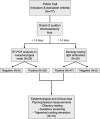Psychophysical evaluation of chemosensory functions 5 weeks after olfactory loss due to COVID-19: a prospective cohort study on 72 patients
- PMID: 32754871
- PMCID: PMC7402072
- DOI: 10.1007/s00405-020-06267-2
Psychophysical evaluation of chemosensory functions 5 weeks after olfactory loss due to COVID-19: a prospective cohort study on 72 patients
Abstract
Purpose: To evaluate the evolution of chemosensation via extended psychophysical testing in patients who suffered from sudden chemosensory loss due to coronavirus disease 2019 (COVID-19). Additionally, this study sought to determine whether odor threshold testing provided additional information on olfactory loss due to COVID-19 compared to the more common odor identification testing.
Methods: Prospective cohort study of patients with sudden chemosensory loss since February 2020 and confirmed COVID-19 infection via RT-PCR or serology testing. Olfactory function was tested extensively using the "Sniffin Sticks" test battery. In addition, we screened gustatory perception and nasal cooling sensations using psychophysical tests.
Results: Seventy-two patients completed the study. After a mean of 37 days, 37% of patients showed olfactory dysfunction, 7% were dysgeusic, and 48% showed signs of low sensitivity for cooling sensation. A longer duration of anosmia before smell improvement was correlated with lower olfactory function at 5 weeks. Odor threshold detection was more affected by COVID-19 compared to odor identification.
Conclusion: Five weeks after developing sudden chemosensory loss due to COVID-19, a high proportion of patients were dysosmic and showed signs of low nasal cooling sensitivity, whereas most of them had normal taste function. SARS-CoV-2 affected mainly odor thresholds, possibly suggesting that the major cause of loss of smell lies at the level of the olfactory neuroepithelium, rather than in the central nervous system.
Keywords: COVID-19; Chemosensory loss; Psychophysical test; SARS-CoV-2.
Conflict of interest statement
Since 2018, Thomas Hummel did research together with and received funding from Sony, Stuttgart, Germany; Smell and Taste Lab, Geneva, Switzerland; Takasago, Paris, France: aspuraclip, Berlin, Germany.
Figures



Similar articles
-
COVID-19: Recovery from Chemosensory Dysfunction. A Multicentre study on Smell and Taste.Laryngoscope. 2021 May;131(5):1095-1100. doi: 10.1002/lary.29383. Epub 2021 Jan 15. Laryngoscope. 2021. PMID: 33404079
-
High prevalence of long-term olfactory dysfunction confirmed by olfactory testing after a community COVID-19 outbreak.HNO. 2022 Mar;70(3):224-231. doi: 10.1007/s00106-021-01129-7. Epub 2021 Dec 23. HNO. 2022. PMID: 34940903 Free PMC article.
-
Subjective versus Psychophysical Measures of Chemosensory Alterations following COVID-19.ORL J Otorhinolaryngol Relat Spec. 2024;86(3-4):107-117. doi: 10.1159/000539378. Epub 2024 May 24. ORL J Otorhinolaryngol Relat Spec. 2024. PMID: 38797162 Free PMC article.
-
Results from psychophysical tests of smell and taste during the course of SARS-CoV-2 infection: a review.Acta Otorhinolaryngol Ital. 2022 Apr;42(Suppl. 1):S20-S35. doi: 10.14639/0392-100X-suppl.1-42-2022-03. Acta Otorhinolaryngol Ital. 2022. PMID: 35763272 Free PMC article. Review.
-
Chemosensory loss in COVID-19.Oral Dis. 2022 Nov;28 Suppl 2:2337-2346. doi: 10.1111/odi.14300. Epub 2022 Jul 14. Oral Dis. 2022. PMID: 35790059 Free PMC article. Review.
Cited by
-
Alteration of Smell and Taste Sensations in Covid-19 Positive Patients: A Prospective Cohort Study in Western India.Indian J Otolaryngol Head Neck Surg. 2021 Sep;73(3):371-377. doi: 10.1007/s12070-021-02670-1. Epub 2021 Jun 8. Indian J Otolaryngol Head Neck Surg. 2021. PMID: 34123736 Free PMC article.
-
Smell Outcome and Seropositivity Titre in Post-COVID-19 Patients.ORL J Otorhinolaryngol Relat Spec. 2023;85(6):305-311. doi: 10.1159/000531222. Epub 2023 Jul 20. ORL J Otorhinolaryngol Relat Spec. 2023. PMID: 37473733 Free PMC article.
-
Chemosensory Dysfunctions Induced by COVID-19 Can Persist up to 7 Months: A Study of Over 700 Healthcare Workers.Chem Senses. 2021 Jan 1;46:bjab038. doi: 10.1093/chemse/bjab038. Chem Senses. 2021. PMID: 34423831 Free PMC article.
-
Persistent Olfactory and Taste Dysfunction after COVID-19.Life (Basel). 2024 Feb 28;14(3):317. doi: 10.3390/life14030317. Life (Basel). 2024. PMID: 38541643 Free PMC article.
-
Temporal Profile of Olfactory Dysfunction in COVID-19.OTO Open. 2020 Dec 7;4(4):2473974X20978133. doi: 10.1177/2473974X20978133. eCollection 2020 Oct-Dec. OTO Open. 2020. PMID: 33330830 Free PMC article.
References
MeSH terms
LinkOut - more resources
Full Text Sources
Medical
Miscellaneous

